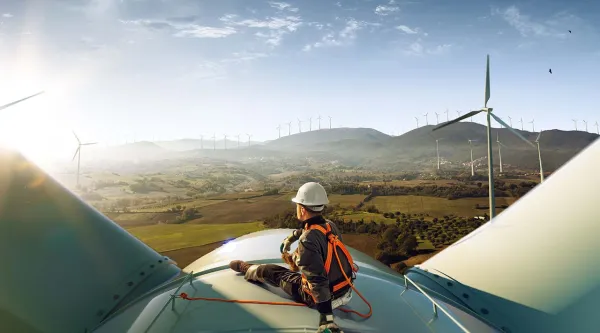Vincent
Dufresne
is
an
energy
engineer
and
a
policy
and
business
analyst
with
extensive
experience
in
the
energy
and
utilities
industry
as
a
business
consultant.
He
is
an
expert
in
energy
transition,
decarbonization,
electrification,
renewable
energy,
energy
efficiency,
...
As the demands of new energy systems evolve rapidly, utilities must invest in grid modernization to provide a safe, reliable and highly resilient energy supply, meet customer expectations and derive greater value from their assets. The 2022 CGI Voice of Our Clients (VOC) reveals that carbon neutrality/distributed energy resources (DERs) is a top industry trend while driving IT modernization to lower costs and increase agility is a top IT priority for energy and utilities executives.
In this Q&A, CGI energy expert Vincent Dufresne discusses what grid modernization entails, its drivers and challenges, and the benefits of distributed energy resource management systems (DERMS).
Q. What does it mean to “modernize the grid”?
Modernizing the grid means upgrading both the hardware and the software that make up the electricity network or grid. Current infrastructure continues to age, and upgrades are needed to tackle new and rapidly increasing challenges. These challenges include coping with increased penetration of variable renewable sources (e.g., wind and solar photovoltaic farms) on wholesale power markets and electrification of transportation, buildings and industrial processes. They also include managing distributed generation and storage units adopted by consumers “behind the meter” (e.g., building-scale solar photovoltaic systems, battery storage, emergency generators, and combined heat and power).
Let’s first talk about modernizing the physical hardware. This entails replacing and adding transmission and distribution wires and transformer stations, adding generation facilities and integrating new distributed generation assets that consumers want to add to their buildings.
Then there’s modernizing the logical software. Software modernization is needed to keep pace with innovation and rising customer expectations and to achieve operational efficiency gains. With so many new challenges, newer systems will be required to collect, store, manage and make sense of far more data than ever before, monitor the grid in a much more granular fashion all the way to its edge (e.g., street transformers and the meters behind them), and improve forecasting of future grid events, not only in the short, medium and long term, but also in the presence of distributed generation.
Furthermore, coping with variable generation, charging/discharging of batteries, electric vehicle (EV) charging, and new winter demand from electric heat pumps will require the ability to monitor even more remote devices—many of which are behind the meters—and send quicker and more frequent control signals.
The variety of equipment that can receive control signals is growing fast. Distributed generation equipment certainly benefits from being controlled. At the same time, utilities will also want to monitor and control other equipment, such as smart thermostats, smart water heaters, advanced building automation systems, networked EV charging stations, and pool pump controllers.
Control signals used to just come in a simple “on/off” form, referred to as demand response, which is a critical DER that will help balance the grid. Increasingly, demand response will morph into more sophisticated, flexible load management in the form of localized dynamic price signals or throttling signals that will be less intrusive and more acceptable to customers. All of this adds up to the need for more and better software.
Of course, all these upgrades will impact the human side of things and require changing associated business processes and re-training personnel. In fact, 57% of energy and utilities executives in our VOC interviews say that culture and change management is a top constraint to achieving business priorities, while 88% say that finding much-needed IT talent is a challenge.
Q: What changes in the energy system are expected as part of the energy transition?
First, there’s going to be a steep electricity demand growth. Second, current and new demand will likely be met by new variable renewable generation sources, mainly solar farms and wind farms, as these are now competitive and affordable solutions. These sources will require more generation sites, as they tend to be added in smaller capacity increments than natural gas-fired, coal, nuclear and large hydroelectric plants. They also need to be located where the resources are, which are remotely dispersed. This means balancing electricity demand with supply will become more challenging. It will require controlling generation facilities and electricity-using technologies in a more granular fashion vis-à-vis where demand and generation sites are located and when electricity is transacted.
Q: What are the key drivers for modernizing the grid and embracing digital transformation in the utilities space?
The energy transition is increasing pressure to modernize the grid. In our VOC interviews, 77% of C-level energy and utilities executives rank sustainability’s impact on future value creation as high. So far, electric utilities, regulators and transmission system operators have balanced the price and affordability of energy services with the reliability of electricity supply. Now, mitigating climate change has become a third—equally important—aspect to consider.
There always has been a drive to modernize the grid periodically as technologies become obsolete and infrastructure ages. Now, climate change is making the modernization challenge even more important—and tricky—because the goal is not just to decarbonize the existing grid but also to decarbonize future electricity demand.
That latter is not trivial. The year-over-year electricity demand growth expected over the next 30 years is unprecedented—not just because populations and economies will grow, but also because we will have to electrify large parts of energy end uses which, today, are served by natural gas, petroleum products and coal. Today, roughly only 15% to 25% of energy end uses are served by electricity. This is a somewhat simplistic image because electro-technologies are much more efficient than their fossil fuel-fired equivalents. Nevertheless, it is illustrative of the magnitude of the challenge. Once efficiency is factored in, decarbonization pathway studies forecast electricity production, transmission and distribution capacity anywhere between doubling and tripling by 2050.
As I mentioned, modernizing the grid means upgrading both hardware and software, but modernizing the latter can potentially reduce the cost of the former and help to keep price, affordability and reliability in check. In addition, modernizing software will allow utilities to right-size their investments in wires, generation facilities, transformers, etc. It will prevent “over-building” or building too hastily, which in turn, would waste resources and cause undue upward pressure on energy prices.
Q. How is climate change catalyzing this shift?
Climate change is triggering two things: 1) accelerated electrification of fossil fuel end-uses on the demand side, and 2) adoption of greenhouse gas emission-free variable new renewables on the supply side. Both will pose challenges to keeping energy affordability and supply reliability in check. Variable renewables are extensively discussed and often identified as the disruptor—and the solution. However, I believe the electrification of transportation, buildings and the industrial sectors will be even more disruptive and will, in turn, require even more variable renewables.
Q. What kind of energy transition-related digital modernization investments will utilities make?
Firstly, utilities will aim to acquire an enterprise-grade distributed energy resource management system (DERMS)—a “DERMS of record,” so to speak.
The enterprise-caliber DERMS is the piece of software that will bind the data, grid status and predictive analysis capabilities, and grid-edge devices’ monitoring and control capabilities. This DERMS will also be able to interface with other similar, smaller-scale DERMS that demand response aggregators and energy efficiency implementation contractors use.
Utilities need these third-party intermediaries to augment their ability to engage and enroll customers into demand response and other DER programs. Typically, these third parties organize around their own DERMS— let’s call them “DERMS Light”—to control the fleet of DER they have recruited. A utility may do business with more than one aggregator to benefit from the effect of competition. The enterprise DERMS is the kernel utilities will need to make sense of this entire, complex ecosystem.
Now let’s go back to the original goal of deploying a DERMS solution, which is to right-size hardware grid investments by managing congestion on the grid and ensuring that any new hardware upgrade is utilized to its full value shortly after the investment is made. The enterprise DERMS will interface with various “DERMS Light” to monitor and control remote devices using the Internet of Things and other communication protocols. It will also pull real-time building electricity consumption data from advanced metering infrastructure, grid typology data, weather forecast and historical usage patterns, and/or grid equipment failure status. Furthermore, the enterprise DERMS will interface with legacy wholesale network control systems to maximize the benefits of DER upstream of the transmission/distribution connection point and throughout the entire electricity value chain.
Secondly, one level above the DERMS, the advanced distribution management system (ADMS) will bridge the gap between the DERMS and the outage management, mobile workforce management and billing and fulfillment systems. The ADMS will bind all of the traditional enterprise systems together that will continue to remain highly relevant. Utilities are updating and modernizing these systems, as they will be used not only to enable the ADMS and enterprise DERMS but also to adapt to the new energy transition reality.
Thirdly and finally, utilities are working on new digital engagement solutions to improve the customer experience. This includes customer relationship management (CRM) systems and platforms, innovative energy efficiency, electrification and demand-side management offerings, digital marketing, and even digital marketplaces to connect customers with relevant equipment providers (e.g., photovoltaic system contractors, heating, ventilation and air conditioning contractors, and EV dealers).
Utilities are doing this to prepare for changes in their business model and their possible new role as transactive energy platform operators instead of simply being wire service providers. To a large degree, utilities do business with DER aggregators, but many of them are also preparing to run their own DER aggregation operations, as this may be a new business opportunity.
Ultimately, DERMS are only worthwhile if they control a large fleet of DER, which, in turn, will only be possible if large numbers of customers are convinced to sign up and let utilities control their devices. These are tricky challenges that require designing attractive customer experiences that bolster customer enrollment retention in DER programs.
Learn more about CGI’s energy and utilities services and solutions, including DERMS.


